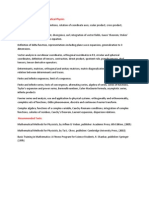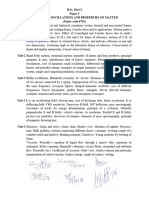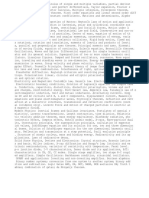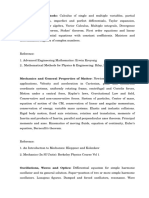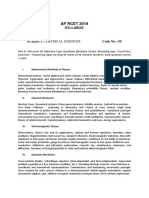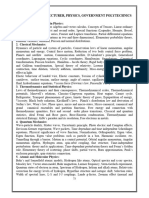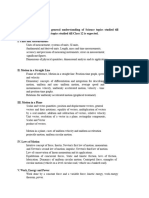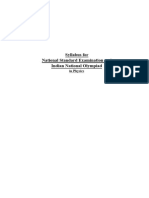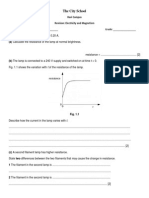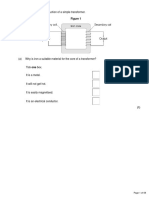0 ratings0% found this document useful (0 votes)
4 viewsCourse Description
Course Description
Uploaded by
naima.shaheen3007Copyright:
© All Rights Reserved
Available Formats
Download as PDF, TXT or read online from Scribd
Course Description
Course Description
Uploaded by
naima.shaheen30070 ratings0% found this document useful (0 votes)
4 views8 pagesOriginal Title
COURSE DESCRIPTION
Copyright
© © All Rights Reserved
Available Formats
PDF, TXT or read online from Scribd
Share this document
Did you find this document useful?
Is this content inappropriate?
Copyright:
© All Rights Reserved
Available Formats
Download as PDF, TXT or read online from Scribd
Download as pdf or txt
0 ratings0% found this document useful (0 votes)
4 views8 pagesCourse Description
Course Description
Uploaded by
naima.shaheen3007Copyright:
© All Rights Reserved
Available Formats
Download as PDF, TXT or read online from Scribd
Download as pdf or txt
You are on page 1of 8
COURSE DESCRIPTION
PH: 301 Methods of Mathematical Physics
Review of vector analysis: definitions, rotation of coordinate axes, scalar product,
cross product,addition of vectors.Differential operators, gradient, divergence, curl,
integration of vector fields, Gauss' theorem, Stokes'theorem, Gauss' law, Poisson's
equation.Definition of delta function, representations including plane wave
expansion, generalization to 3dimensions.Vector analysis in curvilinear
coordinates, orthogonal coordinates in R3, circular and sphericalcoordinates,
definition of tensors, contraction, direct product, quotient rule, pseudo tensors,
dualtensors, tensor derivative operators.Determinants, matrices, orthogonal and
unitary matrices, matrix diagonalization, trace theorem,relation between
determinants and traces.Finite and infinite sequences, limit of a sequence.Finite
and infinite series, tests of convergence, alternating series, algebra of series, series
of functions,Taylor's expansion and power series, Bernoulli numbers, Euler-
Maclaurin formula, asymptotic series,infinite productsFourier series and analysis,
use and application to physical systems. orthogonality and
orthonormality,complete sets of functions, Gibbs phenomenon, discrete and
continuous Fourier transform.Complex algebra, functions of a complex variable,
Cauchy-Riemann conditions, integration of complexfunctions, calculus of residues,
Cauchy's theorem, Laurent expansion, dispersion relations.
Recommended Texts:
Mathematical Methods for Physicists, by Arfken & Weber, publisher: Academic
Press; 6th Edition, (2005)Mathematical Methods for Physicists, by Tai L. Chow,
publisher: Cambridge University Press, (2002)Basic Training in Mathematics: A
Fitness Program for Science Students, R. Shankar, publisher: Springer
PH-302 Basic Electromagnetism.
Vector calculus: vector fields, divergence, curl, Laplacian, Gauss and Green
theorems. Force on a charge ,work, energy. Conductors and insulators. The
concept of induced charge and surface charge, the forceon a conductor.
Coulomb’s law, Electric field, electric field from continuous charge distributions, Gauss’s law
with applications, electric potential of a localized charge distribution, Poisson’s
and Laplace’s equation.
Solutions of Poisson’s and Laplace’s equations in Cartesian, spherical and
cylindrical coordinates .Boundary conditions and uniqueness theorem, methods of
images, charge between parallel plate s,charge outside metallic sphere, induced
surface charges. Multipole expansion, potential due to electric and magnetic
monopoles and dipoles, electric and magnetic dipoles, fields at long and short
distances .Electric polarization and induced dipoles, bound charges and field inside
a dielectric, electric
displacement, Gauss’s law in the presence of dielectrics, electric susceptibility, permittivity
and dielectric constant, boundary value problems in linear dielectric medium,
forces and energy in dielectric systems.Lorentz force, magnetic induction, Biot-
Savart law, magnetic induction due to a long straight current carrying wire and for
a circular loop, Hall effect in semiconductors.
Vector potential, applications of Ampere’s law, multipole expansion of the vector potential.
Introduction to magnetostatics, magnetic field inside matter and the concept of
auxiliary field H.
Ampere’s law in magnetized materials, magnetic susceptibility and permeability. Linear and
nonlinear
media with boundary conditions
Recommended texts:
Introduction to Electrodynamics, by David J. Griffiths, publisher: Prentice-Hall;
3rd Edition, (1999).Electromagnetic Fields and Waves, by Paul Lorrain and
Dale R. Corson, publisher: S. K. Jain for CBSpublishers; 2nd Edition, (2003)
PH-304 Classical Mechanics
Functions, power series representation of an arbitrary function, kinematics, div,
grad, curl. Basictheorems (Gauss, Green).Cylindrical and polar coordinates,
expressions for velocity and acceleration, coordinate transformations,rotating
reference frames.
Newton’s laws, momentum, impulse of a force, applications.
One-dimensional simple harmonic oscillator, damped SHO, forced SHO,
resonance, 3-D SHO, responseto several forces applied simultaneously, linear
superposition principle.Potential energy, conservative and non-conservative
forces.Motion in electromagnetic fields, cyclotron motion, motion in crossed
electric and magnetic fields.Rotating coordinate systems, fictitious forces.Angular
momentum and central forces, planetary motion under inverse-square force,
constants of
motion, Kepler’s Laws, orbital transfers and gravitational boosts, radial oscillations
about a circular orbit.
Systems of particles, motion with a variable mass, rocket motion.Collisions, center
of mass frame, elastic and inelastic collisions.Rotations, angular momentum,
moment of inertia and theorems, the inertia tensor, principal
axes,diagonalization.Principle of least action, Brachistrochrone problem.
Generalized coordinates, Lagrangian mechanics, generalized forces, Hamilton’s
principle, Hamilton’s
equations.Coupled oscillations, normal modes, CO2 oscillation modes.
Recommended texts:
Classical Dynamics of Particles and Systems, by Stephen T. Thornton and Jerry B.
Marion, publisher:Brooks Cole; 5th revised edition, (2006).Classical Mechanics,
by Herbert Goldstein, publisher: Safko and Poole, 3rd Edition (2006).Classical
Mechanics, by John R. Taylor, publisher: University Science books,
(2005).Classical Mechanics by L. Chow, publisher John Willey (1995).
PH-305 Quantum Mechanics-I
Historical motivation: wave-particle duality, photo-electric effect, instability of
atoms, black bodycatastrophe.Observables and operators, postulates of mechanics,
measurement problems, the state function andexpectation values, Schrödinger
wave equation.Time-independent Schrödinger equation and one-dimensional
problems, stationary states,superposition principle, free particles, infinite and finite
square well, harmonic oscillator, and delta-function potential.Hilbert space, Dirac
notation, linear transformations, discrete and continuous basis vectors,
hermitianand unitary operators.Compatible observables, commutators, uncertainty
principle, minimum uncertainty states.Time development of state functions,
symmetries and conservation laws, conservation of parity,operators for time and
space translations.Waves incident on potential barrier, reflection and transmission
coefficients, WKB method.Quantum mechanics in three-dimensions, cartesian and
spherical forms of Schrodinger equation,separation of variables.Rotational
symmetry, angular momentum as a generator of rotations, spherical harmonics and
theirproperties. Completeness and orthonormality properties.
Recommended texts:
Introductory Quantum Mechanics, by Richard L. Liboff, publisher: Addison
Wesley; 4th Edition, (2002).Introduction to Quantum Mechanics, by David J.
Griffiths, publisher: Pearson Prentice Hall, 2nd Edition(2005).Quantum Physics by
Stephen Gasiorowicz, publisher: Willey International, 3rd Edition
PH-401 Quantum Mechanics-II (Pre-requisite PH-305)
Motion of a particle in a central potential. Separation of variables, effective
potential, solution for theCoulomb problem. Spectrum of the hydrogen atom.Spin
as an internal degree of freedom, intrinsic magnetic moment, intrinsic angular
momentum, spin-orbit interaction and total angular momentum.Identical
particles: Many-particle systems, system of distinguishable noninteracting
particles, systemsof identical particles, symmetrization postulate, Pauli exclusion
principle and the periodic table.
Time-independent perturbation theory: Nondegenerate perturbation theory,
degenerate perturbationtheory.The variational principle: Variational theorem,
variational approximation method, the ground state ofhelium atom.The WKB
approximation: WKB wave functions, general connection rules across a classical
turning point,tunneling.Time-dependent perturbation theory: A perturbed two-level
system, perturbation by anelectromagnetic wave, transition into a continuum of
states-
Fermi’s golden rule, Oscillator strengths,
selection rules.Scattering: Classical scattering theory, quantum scattering
theory, partial wave analysis, phase shifts, theBorn approximation.The ad
iabatic approximation: The adiabatic theorem, Berry’s phase, the Aharonov
-Bohm effect.
Recommended texts:
Introductory Quantum Mechanics, by Richard L. Liboff, publisher: Addison
Wesley; 4th Edition, (2002).Introduction to Quantum Mechanics, by David J.
Griffiths, publisher: Pearson Prentice Hall, 2nd Edition(2005).Quantum Physics,
by Stephen Gasiorowicz, publisher: John Wiley, 3rd Edition (2005).
PH-306 Electromagnetic and Relativity Theory (Pre-req. PH-302)
E
lectromotive force and motional emf, Faraday’s law, induced electric field, energy stored in
electric and
magnetic fields.
Current conservation, modification to Ampere’s law, magnetic charge, magnetic monopoles,
Maxwell’s
equations, gauge invariance.Conse
rvation of momentum, Poynting’s theorem, Newton’s third law in electrodynamics,
Newton’sthird law in electrodynamics, Maxwell’s stress tensor, angular momentum of fields.
Magnetic and electric polarizabilities, Maxwell equations in a medium, dielectrics
and magneticmaterials, boundary conditions.Wave equation, general solution,
Fourier expansion, reflection and transmission of plane waves,electromagnetic
waves in vacuum.
Propagation of electromagnetic waves in conducting media and in ionized gases,
reflection andtransmission at normal and oblique incidence, absorption and
dispersion of electromagnetic waves in aconductor.Inertial frames, postulates of
special relativity, invariant interval, Lorentz transformation, time dilationand
length contraction, relativistic Doppler shift.Relativistic energy and momentum,
four-vectors, kinematics of collisions, centre-of-mass, rapidity andpseudo
rapidity.Four vector potentials and currents, covariant form of Maxwell equations,
field strength tensor andconstructed invariants, plane-wave solutions of
Maxwell equations, transversality.
Recommended texts:
Introduction to Electrodynamics, by David J. Griffiths, publisher: Prentice-Hall;
3rd Edition, (1999).Electromagnetic Fields and Waves, by Paul Lorrain and
Dale R. Corson, publisher: S. K. Jain for CBSpublishers; 2nd Edition, (2003).
PH-307 Thermal Physics
First law of thermodynamics, equilibrium, functions of state, internal
energy; reversible changes,enthalpy, heat capacities, reversible adiabatic
changes.Entropy, second law of thermodynamics, Carnot cycle; determination of
entropy in irreversibleprocesses, the approach to equilibrium.Microstates and
macrostates, counting microstates, ensembles and ensemble averaging, approach
toequilibrium.Classical probability, Statistical probability, axioms of probability
theory, probability distributions,discrete and continuous distributions, binomial and
Gaussian distributions, central limit theorem,combinatorics.Microcanonical
systems, definition of a quantum state, entropy and equilibrium in a
microcanonicalsystem, the second law in statistical form (S=klnW)Canonical
ensemble, partition function, entropy in canonical system, Boltzmann
distribution,thermodynamical averages, applications to single particle, factorization
of partition function.Equipartition theorem, free energy and its minimization,
Gibbs and Helmholtz free energy and applications.
Maxwell distribution of molecular speeds, classical probability of a
state, Maxwell-Boltzmann probabilitydistribution, density of states in k-space,
distribution of speeds in a classical gas.Black body radiation, Rayleigh-Jeans
theory, Planck distribution, free energy of a photon gas, Stefan-Boltzmann
formula, phonons.Systems with variable number of particles, chemical potential,
grand canonical ensemble, relation tothermodynamic variables.Identical particles,
fermions and bosons, partition function for identical particles, semi-
classicalapproximations, identical particles localized on a lattice, thermodynamic
properties of a Fermi gas, lowand high temperature regions, Bose condensation,
applications to neutron stars.
Recommended texts:
Introductory Statistical Mechanics, by R. Bowley and M. Sanchez. Publisher:
Clarenden Press, Oxford,2nd Edition (2000).Thermal and Statistical Physics, by H.
Gould and J.Tobochnik, Publisher: Princeton University Press.(2010)Introductory
Statistical Physics, by K. Huang, publisher: CRC, 1st Edition (2001).Thermal
Physics, by C. Kittel and H. Kroemer, second edition, W. H. Freeman (1980)
PH-402 Atomic and Molecular Physics
The hydrogen atom, the Schrödinger equation, solution of the angular equation,
solution of the radialequation, spin of the electron, spin-orbit interaction, the fine
structure of hydrogen, parity, selectionrules, transitions between fine-structure
levels.Helium, the ground state of helium, excited states of helium, spin
eigenstates, transitions in heliumMany electron atoms, shell structure and
the periodic table, Theoretical models for multielectron atoms,The model of
Independent Electrons, The Hartee method, The Hartree-Fock Method,
Configuration Interaction Couplings of Angular Momenta, LS coupling scheme,
jj coupling scheme, hyperfine structure and isotopeshift.Atoms in External Fields,
The Stark Effect, The Zeeman Effect (normal and anomalous Zeeman effects).The
Einstein A and B coefficients, the laser, Pumping, population inversion, rate
equations and lasing conditions, optical resonators.
Fundamentals of Quantum Theory of Chemical Bonding, The Hydrogen-Molecule
Ion H2+, The TunnelEffect, The Hydrogen Molecule H2, Covalent-
Ionic Resonance, Hybridization, The π Electrons of Benzene
C6H6
Recommended Texts:
Physics of Atoms and Molecules, by B.H. Bransden and Joachain, publisher:
Pearson Education 2ndEdition (2003)Atoms, Molecules and Photons, by W.
Demtroder, publisher: Springer (2005)The Physics of Atoms and Quanta, by H.
Haken and H.C. Wolf, publisher: Springer 7th Edition (2004)Atomic Physics, by
C.J. Foot, publisher: Oxford University Press 1st Edition (2005).
PH-404 Sub-Atomic Physics I
Review of accelerators, cross sections, luminosity, electrostatic generators (Van de
Graaff), linearaccelerators (Linacs), beam optics, synchrotrons.Collisons, flux,
intensity, laboratory and center-of-momentum frames, colliding beams, super-
conducting linacs, beam storage and cooling.Passage of radiation through matter,
heavy charged particles, photons, electrons, detectors, scintillationcounters, simple
derivation of Bethe formula, statistical aspects.A first glance at the subatomic zoo:
particles and antiparticles, gauge bosons, leptons, quarks, mesonand baryon ground
states.Rutherford and Mott scattering, form factors, the charge distribution of
spherical nuclei, leptons aspoint probes, nucleon elastic form factors, charge radii
of pion and kaon.Inelastic electron and muon scattering, deep inelastic electron
scattering, structure function for a pointparticle.Nuclear structure: Weizacker mass
formula, volume and surface energies, valley of stability, liquid dropmodel, fermi
gas model.Shell model: magic numbers and closed shells, spin
–
orbit interaction, isobaric analog resonances,coupling with electromagnetic field.
Collective model, nuclear deformations, rotational spectra ofspinless nuclei,
rotational families, one-particle motion in deformed nuclei (Nilsson model),
vibrationalstates in spherical nuclei, interacting boson model, highly excited states,
giant resonances.General description of fission, understanding through liquid drop
and collective models, application topower generation and radioactive dating.
Outline of Big Bang cosmology, primordial nucleosynthesis, stellar energy and
nucleosynthesis, stellarcollapse and neutron stars, cosmic rays, neutrino astronomy
and cosmology, leptogenesis as basis forbaryon excess.
PH-502 Sub-atomic Physics II
Additive conservation laws, conserved quantities and symmetries, electric charge,
baryon number,lepton and lepton flavor number, strangeness and flavor, additive
quantum numbers of quarks.Electromagnetic interaction, electromagnetic
scattering of leptons, vector mesons as mediators of thephoton-hadron interaction,
electron
–
positron collisions and quarks, photon
–
hadron interaction, realand spacelike photons.Importance of P,C,CP, and T
in elementary particle physics, parity operation, intrinsic parities,conservation and
breakdown of parity, charge conjugation, time reversal, two-state problem,
neutralkaons, fall of CP invariance.Weak interactions, muon decay, weak current
of leptons, chirality versus helicity, the weak couplingconstant gf, weak decays of
quarks and the CKM matrix, weak currents in nuclear physics, inverse betadecay,
detection of neutrons, massive neutrinos, Majorana versus Dirac neutrinos, weak
current ofhadrons at high energies,Introduction to gauge theories, Aharonov
–
Bohm effect, gauge invariance for non-abelian fields, Higgsmechanisms,
spontaneous symmetry breaking, gauge bosons and weak isospin, electroweak
interaction,tests of the standard model, quantum chromodynamics, QCD at low
energies.Range and strength of the low-energy strong interaction, Pion
–
nucleon interaction, Yukawa theory ofnuclear forces, low-energy nucleon
–
nucleon force, meson theory of the nucleon
–
nucleon force,strong processes at high energies.Overview: grand unified theories,
supersymmetry, string theories.
Particles and Nuclei: an Introduction to the Physical Concepts, by Povh B, Rith K,
Scholz C and Zetsche F,publisher: Berlin Springer, 5th Edition (2006).Nuclear and
Particle Physics, Martin B R, publisher: New York: Wiley (2006)An Introduction
to the Standard Model of Particle Physics (Kindle Edition) by W. N. Cottingham
(Author),D. A. Greenwood, 2007.
PH-503 Lasers and Quantum Optics
Review of quantum mechanics, Dirac’s notation, Pauli spin matrices, electromagnetic waves
and
photons, wavelength and frequencies of electromagnetic radiation.Spontaneous and
stimulated emission, absorption. Maser principle, cavity, gain medium,
populationinversion, Boltzmann statistics, threshold condition.Three-level laser,
properties of a laser beams, black-body radiation theory. Modes of a
rectangularcavity, Raleigh-Jeans and Planck radiation formula.Semi-classical
treatment of the interaction of radiation and matter. Radiative transition
rates,Interaction Hamiltonian, dipole approximation, rotating-wave approximation,
electric dipole moment,allowed and forbidden transitions, ratio of the electric-
dipole transition probability to the magneticdipole transition probability, transition
cross-section, absorption and gain coefficients.Line-broadening mechanisms.
Homogeneous broadening, collision broadening and natural broadening.Wiener-
Kinchine and Parseval’s theorem. Inhomogeneous and Doppler broadening.
Rate equation approach to Laser theory, stationary solution, time-dependent
solution, Gain, loss andsaturation parameters, lasing condition.Ray and wave
propagation in optical media. Matrix formulation of Geometrical optics. Wave
reflectionand transmission at a dielectric interface. Diffraction optics in paraxial
approximation.Passive optical resonators, plane-parallel (Fabry-Perot) resonator,
concentric, confocal, generalizedspherical and ring resonator. Eigen-modes and
Eigen-values. Stability condition, unstable resonator,photon lifetime and cavity
Q.Q-switching, electro-optical, and acousto-optic Q-switches, saturable absorber
Q-switch.Theory of mode-locking, active and passive mode-locking.Laser
excitation techniques, optical, electrical, and chemical pumping, laser pumping,
excitationtransfer, meta-stable states and lifetimes.Types of lasers, solid-state, dye
and semiconductor lasers, gas, chemical, free electron, and X-ray lasers,laser
applications.
You might also like
- Student Exploration: Free-Fall LaboratoryDocument6 pagesStudent Exploration: Free-Fall LaboratoryCandeluna LorlanNo ratings yet
- Qau Course Outlines PDFDocument11 pagesQau Course Outlines PDFphooolNo ratings yet
- Ja, M SyllabusDocument1 pageJa, M Syllabussoumavo147No ratings yet
- IIT JAM Physics SyllabusDocument2 pagesIIT JAM Physics Syllabuskumar HarshNo ratings yet
- Syllabus For Integrated P H.D. Physics Entrance ExaminationDocument1 pageSyllabus For Integrated P H.D. Physics Entrance ExaminationKrittika AdhikariNo ratings yet
- M.SC Physics (Entrance Test Syllabus)Document2 pagesM.SC Physics (Entrance Test Syllabus)Saroj KumarNo ratings yet
- Iit Jam SyllabusDocument1 pageIit Jam SyllabusMukhil R PillaiNo ratings yet
- SyllabusDocument4 pagesSyllabusshrikant channeNo ratings yet
- B.Sc. Part-I Paper-I Mechanics, Oscillations and Properties of Matter (Paper Code 0793)Document17 pagesB.Sc. Part-I Paper-I Mechanics, Oscillations and Properties of Matter (Paper Code 0793)playergghazlian173No ratings yet
- Jam SylabiiDocument1 pageJam Sylabiisoumya ranjan mohaantyNo ratings yet
- Jam Physics Syllabus: Mathematical MethodsDocument2 pagesJam Physics Syllabus: Mathematical MethodsVenkataramanan SureshNo ratings yet
- CSIR-UGC National Eligibility Test (NET) For Junior Research Fellowship and Lecturer-Ship Physical SciencesDocument7 pagesCSIR-UGC National Eligibility Test (NET) For Junior Research Fellowship and Lecturer-Ship Physical SciencesAbhik SarkarNo ratings yet
- IIT JAM Physics SyllabusDocument2 pagesIIT JAM Physics SyllabusHarshit TiwariNo ratings yet
- For Jam PhysicsDocument3 pagesFor Jam PhysicsDHRUBADCNo ratings yet
- IIT JAM Physics SyllabusDocument3 pagesIIT JAM Physics SyllabusYogandre SinghNo ratings yet
- MSC Physics 2024 PDFDocument7 pagesMSC Physics 2024 PDFashishthardak593No ratings yet
- Jam PH 2019 Syllabus-1Document2 pagesJam PH 2019 Syllabus-1Unique boy RajNo ratings yet
- PH SyllabiDocument2 pagesPH SyllabiSakshi SinghNo ratings yet
- JAM SyllabusDocument4 pagesJAM SyllabusNaveen KuntarNo ratings yet
- Physics (PH) : Mathematical MethodsDocument2 pagesPhysics (PH) : Mathematical MethodsSahidul IslamNo ratings yet
- Physics (PH) Syllabus: Iit JamDocument2 pagesPhysics (PH) Syllabus: Iit JamSrinivasulu PuduNo ratings yet
- NET QuestionsDocument3 pagesNET QuestionsSouvik DasNo ratings yet
- MSC Entrance Syllabus-Physics - 0Document4 pagesMSC Entrance Syllabus-Physics - 0yazh iniNo ratings yet
- Physical Science SET SyllabusDocument4 pagesPhysical Science SET SyllabusNitinNo ratings yet
- Physics Syllabus For IIT-JAMDocument2 pagesPhysics Syllabus For IIT-JAMchowxopunjyotihandiqueNo ratings yet
- NET Syllabus PDFDocument3 pagesNET Syllabus PDFrgdfrNo ratings yet
- CSIR-UGC National Eligibility Test (NET) For Junior Research Fellowship and Lecturer-Ship Physical SciencesDocument3 pagesCSIR-UGC National Eligibility Test (NET) For Junior Research Fellowship and Lecturer-Ship Physical SciencesMaruthiNo ratings yet
- 1.syllabus (M.sc. Physics II)Document7 pages1.syllabus (M.sc. Physics II)Muhammad Hasan RazaNo ratings yet
- B Tech Barch 2919 SylDocument19 pagesB Tech Barch 2919 SylMukhtar AhmedNo ratings yet
- PH SyllabiDocument2 pagesPH SyllabiSuyash SinghNo ratings yet
- IIt JamDocument2 pagesIIt Jamgagandeeprathour.rdrNo ratings yet
- cm phd fellowship examDocument3 pagescm phd fellowship examsandhiyaNo ratings yet
- Physics scqp24Document3 pagesPhysics scqp24pranav.b.patil3373No ratings yet
- AP RCET 2019: SyllabusDocument3 pagesAP RCET 2019: SyllabusEswara SaiNo ratings yet
- Becec SyllabusDocument10 pagesBecec SyllabusHarshit KumarNo ratings yet
- Faculty of Science Master of Computer Applications (M.C.A.) PhysicsDocument6 pagesFaculty of Science Master of Computer Applications (M.C.A.) PhysicsGaurav VarshneyNo ratings yet
- Physicalscience SyllbusDocument3 pagesPhysicalscience Syllbusvincy sundara rajNo ratings yet
- 1.syllabus (M.sc. Physics I)Document7 pages1.syllabus (M.sc. Physics I)Muhammad Hasan RazaNo ratings yet
- Bcece TopicsDocument15 pagesBcece Topicsrajharshit3603No ratings yet
- Jam 2020Document1 pageJam 2020himanshuNo ratings yet
- Syllabus For Written Examination For PGT (Physics) : Unit I: Physical World and MeasurementDocument3 pagesSyllabus For Written Examination For PGT (Physics) : Unit I: Physical World and MeasurementTapabrata DamNo ratings yet
- Info E Book-36-37Document2 pagesInfo E Book-36-37Saikat SenguptaNo ratings yet
- 1C8BDF22-8FED-4D2C-B109-810BF969E936Document6 pages1C8BDF22-8FED-4D2C-B109-810BF969E936ashvinilata2002No ratings yet
- A.P. State Eligibility Test - 2012: Physical SciencesDocument3 pagesA.P. State Eligibility Test - 2012: Physical SciencesSashil ReddyNo ratings yet
- Physics Syllabus UKPSCDocument3 pagesPhysics Syllabus UKPSCBiswajeet MishraNo ratings yet
- Physics I. Mathematical Methods of PhysicsDocument2 pagesPhysics I. Mathematical Methods of PhysicskarnabaluNo ratings yet
- Handbook 1999 ADocument28 pagesHandbook 1999 ARoy VeseyNo ratings yet
- Physics (Hons./Pg) (Code - 26) : Mechanics and General Properties of MatterDocument3 pagesPhysics (Hons./Pg) (Code - 26) : Mechanics and General Properties of Mattersoumendra ghoraiNo ratings yet
- 16-Physical Sciences - SyllabusDocument3 pages16-Physical Sciences - SyllabusUmair AnsariNo ratings yet
- B.Sc. Part I Paper-1 Mechanics and Special Relativity Theory 1.mechanicsDocument2 pagesB.Sc. Part I Paper-1 Mechanics and Special Relativity Theory 1.mechanicsastha singhNo ratings yet
- JAM 2020syllabiDocument1 pageJAM 2020syllabiyash bhatnagarNo ratings yet
- Subject: Physical Sciences Code No.: 02 Gset Syllabus: Mathematical Methods of PhysicsDocument3 pagesSubject: Physical Sciences Code No.: 02 Gset Syllabus: Mathematical Methods of PhysicsTandel RahulNo ratings yet
- Olympaid SyllabusDocument8 pagesOlympaid SyllabusstutiNo ratings yet
- B.sc. (Part III) PhysicsDocument2 pagesB.sc. (Part III) PhysicsBinod TharuNo ratings yet
- NSEP Syllabus 1Document5 pagesNSEP Syllabus 1Anant M NNo ratings yet
- Centre For Theoretical Physics Ph.D. Entrance Examination SyllabusDocument1 pageCentre For Theoretical Physics Ph.D. Entrance Examination SyllabusTabish ShibliNo ratings yet
- 142 SylDocument17 pages142 Sylk gNo ratings yet
- Syllabus For NSEP INPHODocument6 pagesSyllabus For NSEP INPHOrichardfeynman5252No ratings yet
- SET_Physical_Sciences (2)Document3 pagesSET_Physical_Sciences (2)Sachin KaothekarNo ratings yet
- Suction Caisson Foundations For Offshore Wind Turbines: V Congreso Chileno de Ingeniería GeotécnicaDocument10 pagesSuction Caisson Foundations For Offshore Wind Turbines: V Congreso Chileno de Ingeniería GeotécnicaAlex E. MoralesNo ratings yet
- IGCSE I Date Sheet May 2024 REVISEDDocument8 pagesIGCSE I Date Sheet May 2024 REVISEDShahmir RazaNo ratings yet
- GED Science NotesDocument12 pagesGED Science Notesshweyiwin0789No ratings yet
- Maxwell - Hay BridgesDocument20 pagesMaxwell - Hay BridgesAsfand yar khanNo ratings yet
- Applications of Electromagnetic InductionDocument6 pagesApplications of Electromagnetic InductionAdeniji OlusegunNo ratings yet
- I. Objective: A. Topic: Electricity Circuits B. Sub-Topic: Series Circuit C. Materials/Tools/GadgetsDocument7 pagesI. Objective: A. Topic: Electricity Circuits B. Sub-Topic: Series Circuit C. Materials/Tools/GadgetsJhoana Marie RamosNo ratings yet
- Iec 61161 2013Document15 pagesIec 61161 2013adaoNo ratings yet
- Preboard Exam Ee DhvtsuDocument6 pagesPreboard Exam Ee DhvtsuEme Dumlao100% (1)
- Alternating QuantitiesDocument16 pagesAlternating QuantitiesRanjith KotojuNo ratings yet
- 4x25 RM NYY Flexible - Docxx PDFDocument1 page4x25 RM NYY Flexible - Docxx PDFRasel AhmedNo ratings yet
- La Tabella Delle Cadute Di Tensione Unitarie Sui Cavi ElettriciDocument1 pageLa Tabella Delle Cadute Di Tensione Unitarie Sui Cavi ElettriciRajendra Prasad ShuklaNo ratings yet
- Physics QuestionsDocument32 pagesPhysics QuestionsAlyssa ColeNo ratings yet
- SEWEURODRIVE - 20180504 - ITRAGMIC - 4 Traslo RS1526 Per Nuovo Magazzino System LogisticsDocument24 pagesSEWEURODRIVE - 20180504 - ITRAGMIC - 4 Traslo RS1526 Per Nuovo Magazzino System LogisticsFrank SciallaNo ratings yet
- AP Physics C MomentumDocument34 pagesAP Physics C MomentumShamanthakNo ratings yet
- STPM Physics Experiment 8 Earth S Magnetic Field Second Term PDFDocument2 pagesSTPM Physics Experiment 8 Earth S Magnetic Field Second Term PDFVishalinie RamanNo ratings yet
- Intro To Transmission LineDocument13 pagesIntro To Transmission LineJessie DoqueniaNo ratings yet
- Boris ChallengeDocument1 pageBoris Challengedeni ebit nugrohoNo ratings yet
- Revision: Electricity and Magnetism (Physics)Document5 pagesRevision: Electricity and Magnetism (Physics)WahibKamranNo ratings yet
- Samsung FE N500WXDocument6 pagesSamsung FE N500WXboroda2410No ratings yet
- Introduction To Fundamentals of High Voltage EngineeringDocument23 pagesIntroduction To Fundamentals of High Voltage Engineeringawais_sohail89100% (3)
- 049 - B.tech CSE Result (Affiliated Institutes) - 6th Semester - May 2019Document142 pages049 - B.tech CSE Result (Affiliated Institutes) - 6th Semester - May 2019LKNo ratings yet
- Analysis ConcDocument9 pagesAnalysis ConcErnest ChuaNo ratings yet
- Analysing Three Phase Circuits PDFDocument16 pagesAnalysing Three Phase Circuits PDFsenthilNo ratings yet
- STLQGDocument2 pagesSTLQGapi-241908559No ratings yet
- 4 7 3InducedPotentialTransformersandtheNatGrid PDFDocument69 pages4 7 3InducedPotentialTransformersandtheNatGrid PDFlNo ratings yet
- Transmission and Distribution-Mcq by Manas KhandaDocument29 pagesTransmission and Distribution-Mcq by Manas KhandaManas Khanda75% (4)
- PhysicsDPPs Booklet A1 To A45 (JP)Document112 pagesPhysicsDPPs Booklet A1 To A45 (JP)kanika guptaNo ratings yet
- IV Report NewDocument83 pagesIV Report Newsruthy100% (2)
- T.L.E 7 and 8 Week 5Document15 pagesT.L.E 7 and 8 Week 5Eleonor DistrajoNo ratings yet

